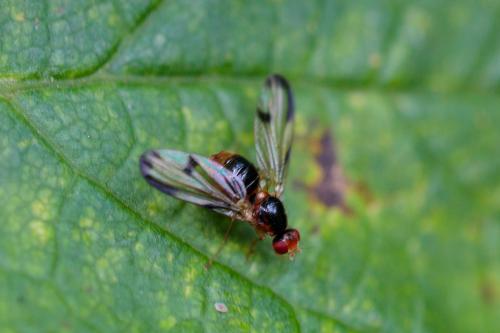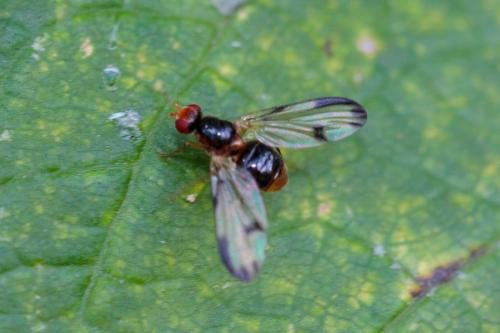Thread subject: Diptera.info :: Sepsid-like pallopterid
Posted by pierred on 14-11-2019 10:32
#1
Hello,
[Click on the picture to get a better resolution. Click again to come back.]

Pierre Duhem : France : Bessans : 73480 : 05/08/2019
Altitude : 1774 m - Taille : 5-7 mm
Réf. : 243384

Pierre Duhem : France : Bessans : 73480 : 05/08/2019
Altitude : 1774 m - Taille : 5-7 mm
Réf. : 243385
It looks like a sepsid, but with this brown scutellum and the brown segments at apex of the abdomen, it doesn't fit. I searched also in the usual families with decorated wings, but with no result.
Can somebody give me an orientation?
Thanks in advance.
Edited by pierred on 15-11-2019 09:37
Posted by Ectemnius on 14-11-2019 13:14
#2
Hello pierred,
Actually it is a Pallopteridae. Looks like Palloptera usta.
Kind regards,
Ectemnius
Posted by Paul Beuk on 14-11-2019 13:16
#3
It is a pallopterid, but I have difficulty in finding a species with glossy black mesonotum, yellow scutellum, glossy black abdomen but terminal segments again yellow and this wing pattern. Did you collect it?
Posted by pierred on 14-11-2019 13:34
#4
No, I didn't collect it.
Note that this is in the French Alps, rather high (1775 masl).
Posted by Xylosoma on 18-11-2019 08:30
#5
This is Temnosira ambusta. Thorax coloration should be even variable as in T. saltuum, vary from orange to black and typically shining. Nice observation, I have seen only single specimen in many years.
Xylo
Posted by pierred on 18-11-2019 09:47
#6
Thanks a lot.
Paul,
Do you want the pictures in the gallery?
Edited by pierred on 18-11-2019 09:53
Posted by Paul Beuk on 18-11-2019 20:20
#7
Of course :D
Posted by pierred on 18-11-2019 20:44
#8
I'll do it.
Posted by libor on 18-11-2019 22:01
#9
Noooo! Ambusta has orange thorax with black longitudinal lines. Ectemnius is right, this is Toxoneura usta, a species of cold habitats in medium and higher altitudes. Note: probably living on trees and shrubs above the ground (unpublished).
Libor
Posted by Jan Willem on 18-11-2019 22:13
#10
As far as I remember
T. usta doesn't have such a shiny mesonotum and doesn't have a yellowish scutellum. I think Xylo is right! Seems like the coloration of the mesonotum of
T. ambusta being rather variable. So I'm not at all convinced about this being
T. usta!
Posted by libor on 18-11-2019 22:24
#11
Oh, really? I know no paper about black mesonotum in ambusta... Can I get any paper with this note?
If Xylo and Jan are right, I am very sorry for my previous message!
Libor
Posted by Xylosoma on 19-11-2019 07:54
#12
I have in my collection specimens of T. ambusta with 4 longitudinal black lines on mesonotum, with 2 submedian stripes and outer ones broken at suture into spots, and with a pair of enlarged and broadly fused stripes leaving only a small orange midline. The shown specimen is only a little bit darker with central disc of mesonotom completly black. No doupts that T. ambusta is variable in coloration of mesonotum. Frons of the figured specimen is typically orange accept occuput, in P. usta only the anterior part is orange but dark and thickly gray dusted posteriorly.
Xylo
Posted by Paul Beuk on 19-11-2019 13:09
#13
Ozerov does not mention the variation in his 2009 review of the Russian Pallopteridae. However, in his key the species appears next to
shatalkini that does have an entirely glossy black mesonotum and similar wing pattern. Makes you wonder...
Posted by Ectemnius on 19-11-2019 13:45
#14
Well, I dont know anything about Pallopteridae. So I just suggested a name. Jan-Willem and Xylosoma obviously do know their Pallopteridae. That brings me to the following:
I thought that Temnosira and Palloptera were synonymised? They are on the Dutch checklist... Does anyone know where that was done?
And is there any key available anywhere for Pallopteridae. I have the Morge and Ozerov papers. Both are annoying to use.
Kind regards,
Ectemnius
Posted by Paul Beuk on 19-11-2019 16:10
#15
The online checklist of Dutch Diptera uses
Palloptera only. Ozerov placed
Temnosira as synonym of
Toxoneura. I think the genera shift into and out of synonymy depending on who you use as authority. I am not certain there are many formal synonymizations or resurrections...
'Some of us' are still trying to say something sensible about the validity of the different genera but unfortunately one of us had a physical mishap and is only just now getting up and running again. I hope to get us up and running again early next year.
Posted by Jan Willem on 19-11-2019 17:16
#16
Well to be honest, I also don't know a publication mentioning a black mesonotum in
T. ambusta (or
P. ambusta :-) ). However, I also don't know a publication mentioning a shining mesonotum in
T. usta. It's a pity we don't have more details on the specimen.
Posted by Xylosoma on 19-11-2019 17:17
#17
Yes, Ozerov discussed Temnosira as junior synonym of Toxoneura. This synonymy apparently is not in use. Papp redefined Pallopteridae in 2011 and gives Temmnosira and Toxoneura as distinct genera. At the same time, he reinstated Eurygnathomyiidae as separate family which does not establish in recent publications or Fauna Europae. Diptera.org/diptera.dk seems to be offline today to check this out.
Ozerov described his shatalkini from Altai in the genus Temnosira. Unfortunately, I don’t have this paper. In his publication to Russian Pallopteridae he somehow forgotten this fact in the key and did not set the authors (his) name in parentheses. The figures of wings of T. ambusta and T. shatalkini aren’t showing any differences.
The main question is: Who is going to Alps next summer to collect some more ambusta with complete dark disc of mesonotum 😉 . I have collected all my described colour variations in France.
Xylo

